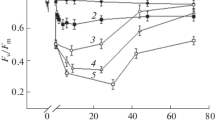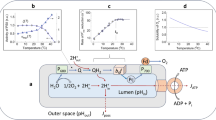Abstract
Photosynthetic CO2 fixation rates in leaves and intact chloroplasts of spinach measured at 18°–20° C are substantially decreased by pretreatment at temperatures exceeding 20° C. Mild heating which causes 80% inhibition of CO2 fixation does not affect phosphoglyceroacid reduction and causes increases in the ATP/ADP ratio and the light-induced transthylakoid proton gradient. The inactivation of the CO2 fixation is completely reversible with half-times of recovery in the order of 15–20 min. Comparison of steady-state patterns of 14C labeled Calvin cycle intermediates of heat-treated and control samples reveals a large increase in the ribulose-1,5-bisphosphate/phosphoglyceroacid ratio and a large decrease in the phosphoglyceroacid/triosephosphate ratio. It is concluded that inactivation of CO2 fixation occurring at elevated temperatures is caused by inhibition of the ribulose-1,5-bisphosphate carboxylase (EC 4.1.1.39). Measurements of light-induced light scattering changes of thylakoids and of the light-induced electrochromic absorption shift show that these signals are affected by mild heating in a way which is strictly correlated with the inactivation of the CO2 fixation. It is proposed that the function of the ribulose-1,5-bisphosphate carboxylase in vivo requires a form of activation that involves properties of the thylakoid membrane which are affected by the heat treatment. The fact that these changes in thylakoid membrane properties and of ribulose-1,5-bisphosphate carboxylase activity are already affected at elevated temperatures which can still be considered physiological, and the reversible nature of these changes, suggest that they may play a role in temperature regulation of the overall photosynthetic process.
Similar content being viewed by others
Abbreviations
- 9-AA:
-
9-aminoacridine
- DMO:
-
5,5-dimethyloxazolidine-2,4-dione
- FBP:
-
fructose-1,6-bisphosphate
- HEPES:
-
N-2-hydroxyethylpiperazine N-2-ethane sulfonic acid
- HMP:
-
hexose monophosphates
- PGA:
-
3-phosphoglycerate
- PMP:
-
pentose monophosphates
- RuBP:
-
ribulose-1,5-bisphosphate
- SBP:
-
seduheptulose-1,7-bisphosphate
- TP:
-
triose monophosphates
References
Akazawa, T. (1977) Structure and function of ribulose bisphosphate carboxylase. In: Proceedings of the Fourth International Congress on Photosynthesis, pp. 447–456, Hall, D.O., Coombs, J., Goodwin, T.W. eds. Biochem. Soc., London
Akazawa, T. (1979) Ribulose-1,5-Bisphosphate Carboxylase. In: Encyclopedia of Plant Physiology, vol. 6, pp. 208–225, Gibbs, M., Latzko, E. eds. Springer, Berlin Heidelberg New York
Baldry, C.W., Bucke, C., Walker, D.A. (1966) Temperature and photosynthesis. I. Some effects of temperature on carbon dioxide fixation by isolated chloroplasts. Biochim. Biophys. Acta 126, 207–213
Björkman, O. (1975) Thermal stability of the photosynthetic apparatus in intact leaves. Carnegie Inst. Year Book 74, 751–759
Björkman, O., Boyton, J., Berry, J. (1976) Comparison of the heat stability of photosynthesis, chloroplast membrane reactions, photosynthetic enzymes, and soluble protein in leaves of heat adapted and cold adapted C4 species. Carnegie Inst. Year Book 75, 400–407
Döring, G., Renger, G., Vater, J., Witt, H.T. (1969) Properties of the photoactive chlorophyll-a II in photosynthesis. Z. Naturforsch. 24b, 1139–1143
Emerson, R. (1929) Photosynthesis as a function of light intensity and of temperature with different concentrations of chlorophyll. J. Gen. Physiol. 12, 623–639
Giersch, Ch. (1979) Quantitative high-performance liquid chromatographic analysis of 14C-labelled photosynthetic intermediates in isolated intact chloroplasts. J. Chromatogr. 172, 153–161
Heber, U. (1969) Conformational changes of chloroplasts induced by illumination of leaves in vivo. Biochim. Biophys. Acta 180, 302–319
Heber, U. (1973) Stoichiometry of reduction of phosphorylation during illumination of intact chloroplasts. Biochim. Biophys. Acta 305, 140–152
Heber, U., Santarius, K.A. (1970) Direct and indirect transfer of ATP and ADP across the chloroplast envelope. Z. Naturforsch. 25b, 718–728
Heber, U., Enser, U., Weis, E., Ziem, U., Giersch, Ch. (1979) Regulation of the photosynthetic carbon cycle, phosphorylation and electron transport in illuminated chloroplasts. In: Proc. of the ICN-UCLA Symposium on covalent and noncovalent of protein function, pp. 113–137, Atkinson, D.E. ed. Academic. Press, New York San Francisco London
Heldt, H.W., Werdan, K., Milovancev, M., Geller, G. (1973) Alkalisation of the chloroplast stroma caused by light-dependent proton flux into the thylakoid space. Biochim. Biophys. Acta 314, 224–241
Jensen, R.G., Bassham, J.A. (1966) Photosynthesis by isolated chloroplasts. Proc. Natl. Acad. Sci. USA 56, 1095–110
Krause, G.H. (1973) The high-energy state of the thylakoid system as indicated by chlorophyll fluorescence and chloroplast shrinkage. Biochim. Biophys. Acta 292, 715–728
Krause, G.H., Santarius, K.A. (1975) Relative thermostability of the chloroplast envelope. Planta 127, 285–295
Lilley, R. McC., Chong Ja Chong, Mosbach, A., Heldt, H.W. (1977) The distribution of metabolites between spinach chloroplasts and medium during photosynthesis in vitro. Biochim. Biophys. Acta 460, 259–272
Mooney, H.A., Björkman, O., Collatz, G.J. (1977) Photosynthetic acclimation to temperature and water stress in the desert shrub Larrea divaricata. Carnegie Inst. Year Book 76, 328–335
Mukohata, Y., Yagi, T., Higashida, M., Shinozaki, K., Matsuno, A. (1973) Biophysical studies on subcellular particles VI. Photosynthetic activities in isolated spinach chloroplasts after transient warming. Plant Cell Physiol. 14, 111–118
Murakami, S., Packer, L. (1970) Protonation and chloroplast membrane structure. J. Cell Biol. 47, 332–351
Rumberg, B. (1977) Field Changes. In: Encyclopedia of Plant Physiology, vol. 5, pp. 405–414, Trebst, A., Avron, M. eds. Springer, Berlin Heidelberg New York
Santarius, K.A. (1975) Sites of heat sensitivity in chloroplasts and differential inactivation of cyclic and noncyclic photophosphorylation by heating. J. Term. Biol. 1, 101–107
Santarius, K.A., Müller, M. (1979) Investigations on heat resistance of spinach leaves. Planta 146, 529–538
Schreiber, U., Armond, P.A. (1978) Heat induced changes of chlorophyll fluorescence in isolated chloroplasts and related heatdamage at the pigment level. Biochim. Biophys. Acta 502, 138–151
Schuldiner, S., Rottenberg, H., Avron, M. (1972) Formation of ΔpH in chloroplasts. 2. Fluorescent amines as a probe for the determination of ΔpH in chloroplasts. Eur. J. Biochem. 25, 64–70
Seemann, J.R., Downtown, W.J.S., Berry, J.A. (1980) Field studies of acclimation to high temperature: winter ephemerals in death valley. Carnegie Inst. Year Book 79, 157–162
Selwyn, M.J. (1966) Temperature and Photosynthesis. II. A mechanism for the effects of temperature on carbon dioxide fixation. Biochim. Biophys. Acta 126, 214–224
Thorne, S.W., Horvath, G., Kahn, A., Broadman, N.K. (1975) Light-dependent absorption and selective scattering changes at 518 nm in chloroplast thylakoid membranes. Proc. Natl. Acad. Sci. USA 72, 3858–3861
Tillberg, J.E., Giersch, C., Heber, U. (1976) CO2 reduction by intact chloroplasts under a deminished proton gradient. Biochim. Biophys. Acta 461, 31–47
Träuble, H. and Eibl, H., (1974) Electrostatic effects on lipid phase transitions: Membrane structure and ionic environment. Proc. Natl. Acad. Sci. USA 71, 219
Warburg, O. (1969) The velocity of the biochemical decomposition of carbon dioxide in the living cell. Biochem. Z. 100, 230–270
Werdan, K., Heldt, H., Milovancev, M. (1975) Role of pH in the regulation of carbon fixation in the chloroplast stroma. Carbon dioxide fixation in the light and dark. Biochim. Biophys. Acta 396, 276–292
Witt, T.H. (1979) Energy conservation in the functial membrane of photosynthesis by light pulse and electrical pulse methods. The central role of the electrical fields. Biochim. Biophys. Acta 505, 355–427
Yabusoe, M. (1924) The temperature coefficient of carbon dioxide assimilation. Biochem. Z. 152, 498–503
Author information
Authors and Affiliations
Rights and permissions
About this article
Cite this article
Weis, E. Reversible heat-inactivation of the calvin cycle: A possible mechanism of the temperature regulation of photosynthesis. Planta 151, 33–39 (1981). https://doi.org/10.1007/BF00384234
Received:
Accepted:
Issue Date:
DOI: https://doi.org/10.1007/BF00384234




